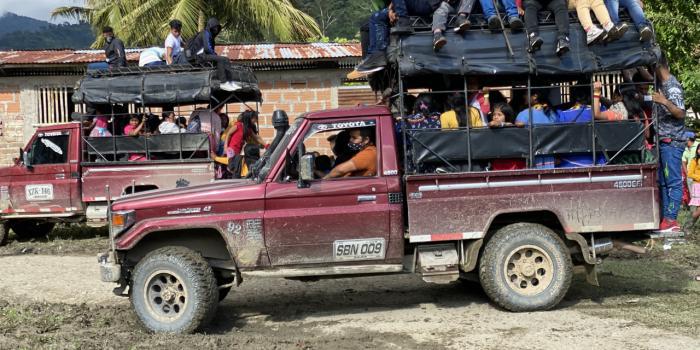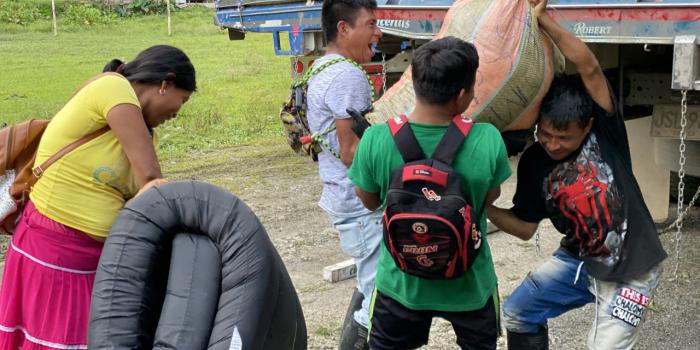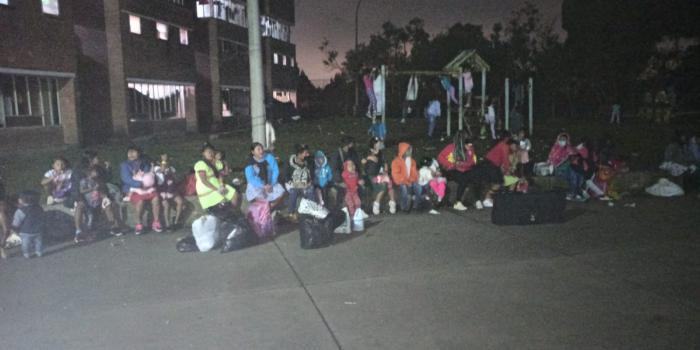
Chronicle of a Return Foretold
In December, 1,165 displaced Emberas indigenous people who were in La Florida Park, in Bogota, returned to their ancestral lands in Risaralda and Choco. Many spent more than two years surviving in the capital, a stay that wasn’t easy at all.



By Erick González G. and Edwin Herrera
Come on, come on, come on! They yell from the buses set up in a single line. The car horns repeat this intention. Each call has a little of mountain, fauna, peaceful grass and a clean, warm, country air. Each blow from the buses horns seems to urgently invoke the sacred spirits to guide both Embera’s women and men in the return to the worldview’s portal, in Mistrato and Pueblo Bello, in Risaralda, and allow them to leave, under their protection, this 'chaosvision' of crowds and cold that is common in the capital.
On December 1st, these calls echo in Parque La Florida, on Bogota’s edge over Calle 80, at eight o'clock at night, where 125 Embera Chami families swarm. They survived for a time the exile suffered by, according to them, the ELN.
Along their journey through the asphalt, Bogota's indifference and lack of empathy weren’t always in those three two-and three-story brick masses that look like a citadel model, an urban habitat intent with two ghettos capacity: the Embera Chami and the Embera Katios. As the great Mexican writer Juan Villoro would say in his chronicles work El vertigo horizontal: “A bedroom city”.
I say they survived, not that they stayed, that they were guests or even welcomed, because those words are written with hospitality or at least some warmth, and this kind of apartheid, where they needed to be gathered so the Unit for the Victims could achieve their return to Risaralda’s lands, is stripped of these qualities, even though there was protection from entities responsible for their maintenance and health.
For many Emberas, it has been more than two years sleeping in quite dissimilar sectors. Some say they have reached Ciudad Bolivar; others, the Republica de Canada sector in the southeastern hills on the road to Villavicencio. Changing the order of places doesn’t change the product: to survive at all costs.
Some men found jobs like Jose Arley, 27, who led the mass return process of his Chami people. He earned his keep in construction. He sweated a million five hundred COP a month while he was able to, because when he got to Parque Florida, he had to give up that salary.
Apparently, the ones who worked the most were women. It isn’t clear if this happened whether due to maternal survival instinct or by paternal neglect, or both, but some women went out to sell beads Downtown at Plaza de Bolivar, a capital and marginal point, among doves and prayers, where need looks for a profit margin.
In many people sad biography, this sector of the septimazo (7th Avenue), which is characterized by the daily lunch with soup, beans, rice, and juice until the 26th Street, is perhaps the first rehearsal of business in their lives, which according to their lucks can be a room they pay daily, how they pay the daily collector and how they get money in daily basis.
This sector, a benchmark in begging and street vending, is where both sectors of the informal economy, through a thousand pesos eyeglasses, Hollywood movies or art cinema DVD’s, music memories, indigenous handicrafts, quartz, cellphone minute sales, lottery, aged or new trendy vinyl’s, candy, clothing, coffee, herbal teas, megaphones, and charities, is where people hope that luck doesn’t leave them aside.
There, “we sold the beads for 15,000, 30,000 pesos. Sometimes we didn't sell anything during the day,” says Adelina Nengarabichacoa, an Embera Chami who was waiting to return to her town, in Risaralda, just 20 days after the first returned group.
Although that marginality has spread and gotten stranger. In this world of "mix", "club mix", "feature", "remake", "revival" and "reboot", which ultimately are nothing more than tools for artistic changes to adapt to economy demands, on a planet that doesn’t manage to remaster itself, you can see indigenous Embera Katio girls, almost toddlers, in North Bogota’s streets, in a two by two meters space, as if it were a micro indigenous town, assimilating injustice with handicrafts sale and adapting their dances to the circumstances to encourage charity.
The poet Mario Benedetti would say that is the tactic and strategy for their survival. In the north of the city, their dances cannot compete with people that do Michael Jackson's choreography for change. In that dispute, is it necessary to say who loses?
This photograph of the mother with her displaced daughters and a speaker can be taken on 81st Street with 9th Avenue, northeast corner, or on 87th Street with 11th Avenue, western side. The frame is the same, it only changes the number of girls and babies. Why aren´t indigenous men seen in the same survival attitude?
"The men go out to buy clothes that later they resell", says Adelina, although she flutters dissatisfaction with her answer. Would the role change be bold?
The second group
The all that says: “Come on, come on, come on! is also heard on December 20th. This film of the mother and father with their children, in Parque La Florida, is a remake of December 1st, but it is an 11 pm show. The argument is the same, the photography, the people’s crowded movement, the courtship ... not even the secondary actors or public officials change, perhaps the extras change a little – the media –; what does change is the buses and families’ number and this adds another place to return to: three trucks with belongings, twelve buses, 125 families, 415 people on December 1st. Twenty buses, five trucks, 750 people, 215 families leave on December 20th, of which 115 go to Bagado, in Choco, and 100 to Pueblo Rico, in Risaralda.
For this logistics of one goodbye – although Colombia is so indecipherable that it might as well be the test of a see you soon – the Unit for the Victims placed, at the start and finish, 29 officials and $1,500 million COP for both return phases.
In the promised land
The true return begins with the trucks’ arrival to the territory. The reception place’s school – as it always is when this happens – becomes a temporary warehouse for the returned belongings.
Led by the Indigenous Guard and with their Governor instructions, Julio Alberto Nayaza, a dozen small men of no more than 160 centimeters, with strength that contradicts their size, begin the parade, towards the biggest or smallest classroom? of cabinets, bicycles, beds, stoves, clothes and even a washing machine that wonders locals and strangers.
Tie ropes, hammers, machetes, saws, flat files, hoes, barrettes and 4,800 zinc tiles are part of the other inventory that complete the home improvement kits, which State institutions provide to returned and receiving families.
D-Day arrived. The dim dawn light on December 2nd colors the receiving families’ women costumes who were awake for five hours before their relatives and friends’ arrival; they all share a farewell, its motive, and the information: more than 700 days of that memory.
When the buses are seen, some claps and the occasional tear fled the Embera stoicism. After traveling all night, and much of it without sleeping, just over 400 people disembarked in Pueblo Rico’s main park. There were 900 people fused in a single hug.
The almost 30 degrees and the humidity of the Choco limits forces them to place their jackets to the waist and to roll up their sleeves.
This stop has a double purpose: to demand Humanitarian Aid and the materials to arrange the last diaspora. Many are expected in the jeeps that will drive them through their final stretch of just over an hour to the village of Gito Dokabu. The other families compass point to other reservations located in the Paparido, Lumade, Chipa, Arenales, Santa Rita, Sinai, Morocco, Barakirura and Alto Barakirura ethnic territories, among others; some are four hours away on the back of a mule and others must use modern means, half an hour by tricycle.
“It is a huge joy to be able to reach our territory where family and friends wait for us. I’m happy, the truth is I have no more words to describe what I feel, living in Bogota isn’t easy, we went through many needs, while here you can find food easier,” says Jose Arley Siagama.
Libardo Mulato Campo, 18, experienced the same joy on December 22nd. He worked for other communities while in Bogota. "I’m very happy to return," he said. He came back with savings to invest in his home.
That excitement is shared by Herminia Enembare Kama, that is the name understood in the scarce Spanish of this Embera Chami woman who cannot read or write, a hardship she traveled with to the city, where she sold bead crafts with her four children and no husband; she did this to support herself and buy clothes for the capital's cold. "It feels good to be back in the homeland," she says.
Now, all the returned Embera have the same hope as Jose Arley: “We hope the institutions don´t forget us and comply with everything we have agreed upon, we want decent conditions to remain in the territory; we had a super trip, but this is not only about returning, it is what comes from now on, especially in terms of housing and crops."
On these Christmas days, the returnees “give infinite thanks for such a sovereign benefit”[1], especially when, for many migrants, Bogota is a patient gravedigger. The displacement asks to be compensated with stories. And the orality, so closely related to these communities, will take care of that lesson.
(Fin/EGG/COG/RAM)
[1] This sentence comes from a common pray Colombians do for nine days before Christmas.






